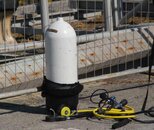You are using an out of date browser. It may not display this or other websites correctly.
You should upgrade or use an alternative browser.
You should upgrade or use an alternative browser.
Oxygen tank explosion injures one - Italy
- Thread starter DandyDon
- Start date
Please register or login
Welcome to ScubaBoard, the world's largest scuba diving community. Registration is not required to read the forums, but we encourage you to join. Joining has its benefits and enables you to participate in the discussions.
Benefits of registering include
- Ability to post and comment on topics and discussions.
- A Free photo gallery to share your dive photos with the world.
- You can make this box go away
windapp
Contributor
The part where the tank exploded and landed 150 meters from the location of the incident.
Sounds like a lot of force for just air and nothing combusting. Could be air though I suppose
An oxygen cylinder would not combust either on rupture. Required for combustion is both oxidizer and fuel. You only have one of the two in a properly cleaned oxygen cylinder. Air at 200 atmospheres has a tremendous amount of energy. The tank would have been like a rocket. This is why they take some much effort to ensure all of the air is purged for hydrostatic testing.
Griffo
Contributor
I wonder if it's a repeat of this accident?
http://www.deir.qld.gov.au/workplace/publications/alerts/mismatchingdanger/index.htm
The cyliner looks like a faber, so likely has a 3/4 thread. Someone buys a cheap valve from the UK over the net, not realising that it's M25....
http://www.deir.qld.gov.au/workplace/publications/alerts/mismatchingdanger/index.htm
The cyliner looks like a faber, so likely has a 3/4 thread. Someone buys a cheap valve from the UK over the net, not realising that it's M25....
rickgillyon
Registered
In Italy, so more likely to be 25mm.The cyliner looks like a faber, so likely has a 3/4 thread.
james croft
Contributor
I wonder if it's a repeat of this accident?
Dangers associated with mismatching portable (scuba) cylinders and valve fittings - Workplace Health and Safety Queensland
The cyliner looks like a faber, so likely has a 3/4 thread. Someone buys a cheap valve from the UK over the net, not realising that it's M25....
That was my thought when I saw the tank. It sound very plausible.
moosicman
Contributor
I'm always nervous about tanks, even though I know the odds are greatly in my favor. I used to work for Pepsi and we had C02 cylinders for fountain machines that would pop their seal. Sounded like a cannon going off. They wouldn't go anywhere as they were usually secured but the whole tank would ice up in seconds. I guess it made me gun shy of scuba tanks (that and reading about these type accidents - I never like to stand around when they are filling tanks).
Chilly_Dipper
Contributor
The part where the tank exploded and landed 150 meters from the location of the incident.
Sounds like a lot of force for just air and nothing combusting. Could be air though I suppose.
Sent from my Shearwater Predator...
Actually there is an incredible amount of energy stored in a SCUBA cylinder (any compress gas cylinder) if you do some back of the envelope calcs you'll quickly see how much
Work = Force*distance and Pressure = Force /Area so Work = Pressure*Area*Distance = Pressure*Volume
That means (forgive the metric here my American friends) the work the energy stored in a standard 80L tank pressurized to 200 BAR (2800psi) could potentially do is 16,000 Joules doesn't seem like a lot yet? Well Power = Work/Time how long does it take for a tank to explode? Lets be generous and call it 1/100 of a second that means that the power of a single 80L tank exploding would be 1 million Watts of power or 1MEGAWATT or for the benefit of my American friends ~2100 Horse Power!
That guy should be happy to only have lost a couple teeth and suffered some bruising....
Cheers,
CD
CT-Rich
Contributor
That tank could have gone near to orbit. I agree he got off real lucky. The Mythbusters did an episode knocking avalve off a tank it made a pretty, round hole in in a cinderblock wall, not unlike what a cartoon character would make. My guess is that he was hit with shrapnel or the valve. If the tank had hit him while discharging even with a richochet he would be dead.
tech_diver
Contributor
It is hard to tell for sure from the low resolution photo but there appears to be exposed brass around the threads of the valve. This would be consistent with the valve thread mismatch theory. It is really scary how close the three quarters and the M25 are. The valve goes in with some slop at first but with a wrench you can tighten it enough to feel secure while the threads are barely engaged.
technicalbeast
Contributor
may be the threads of the cylinder where the valve have to fitted is been not inspected.....this is maybe by long term use by screwing and unscrewing the threads just got rubbed....
Similar threads
- Replies
- 3
- Views
- 986
- Replies
- 0
- Views
- 483
- Replies
- 44
- Views
- 5,140
- Replies
- 39
- Views
- 7,040





